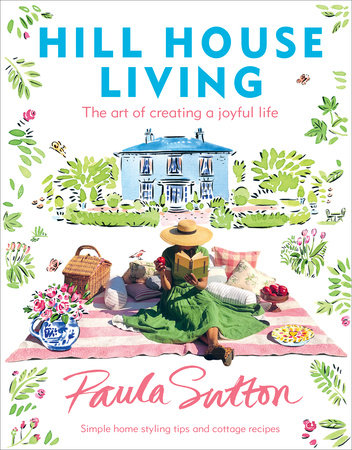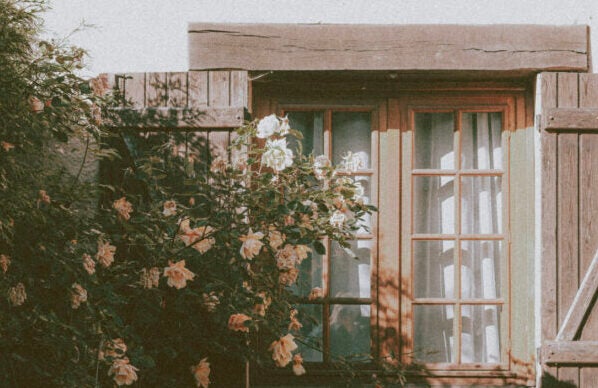From Catwalks to Dog Walks and Couture to ManureI’m just pondering how a high-heel-loving, disco-dancing, Vogue-buying Londoner like myself ended up becoming obsessed with old buildings, period architecture, vintage treasures and all things floral and antique. Was I always programmed to morph into a tweed-wearing character from an Enid Blyton novel, or did I fall and hit my head somewhere along the way, and awake to find that my penchant for designer shoes had been replaced by an appetite for multi-layered Victoria sponge cake overnight? Whatever the reason, give me a period property with a perfectly planted garden to drool over and a slow-paced life in the English countryside over the hustle and bustle of city living any day. From couture to manure—I’ve gone from catwalk to dog walk in the most literal sense . . . London gave me a high-octane start, but Norfolk ended up stealing my heart! Who’d have thought that slow and steady would win the day after all! This blog post that I wrote several years ago is what initially got me thinking about writing a book. Like so many before me, I had chosen to change my life and follow my intuition. This led me to a world of self-discovery and joy. A little over a decade ago, I decided with my husband to transport our family from the busy streets of south London to a small village in Norfolk where we didn’t know a soul. One day, I was stuck in traffic on the South Circular attempting to get my three children to their multicultural, thousand-pupil-strong prep school. The next, we were standing in the middle of a village playground belonging to a school that numbered only 90 students, with me and the children as the only residents of colour for miles around.
Thankfully, my leap of faith has an extremely happy and positive ending. But I’ve often wondered, what is it about the countryside that lures so many dedicated metropolitan types like my former self to experience a slower-paced way of living, and do you really need to move away to achieve it?
During my 20 years of working in the fashion industry in London, I produced some of the glossiest and most glamorous fashion shoots and magazine covers for one of the world’s leading fashion magazines. Time and time again, despite our collective penchant for all things modern, on trend and (seemingly) sophisticated, there would be at least one fashion spread per season that would hark back to an immaculately bucolic version of the countryside. Whether it was a playful take on allotment living, 1940s Land Girl chic, Aga-baking squire or chicken-breeding debutante, the dream-filled image of the merry homesteader was ever-present. However, for me, the allure started way before then. To fully understand how and why I morphed, it’s important to go back to the beginning. So here is my story . . .
As the daughter of West Indian immigrants who settled in south London during the early 1960s, my love of all things country had—on first inspection—no obvious origin. But upon reflection, one clue is my mother’s ‘addiction’ to Country Life magazine, which I subsequently adopted when, from an early age, I started to flick through her discarded copies.
Like me, my mother was an avid Jane Austen fan, and she had dreamed of living in a house in the English countryside. However, upon their arrival from the Caribbean, my parents’ reality was a series of bedsits and lettings, followed by a slow but steady move up the property ladder, culminating in a far more modest than Pemberley-esque Edwardian house in a south London suburb. For my mother, it was the house where her dreams of acquiring her own version of an English home had finally been fulfilled, and by realising those dreams my mother provided the basis for my own romantic leanings towards English country houses and interiors that were more traditionally flavoured than the modern preferences of my contemporaries.
Despite not having come from a background where family heirlooms were passed down, I did inherit a make-do mentality. So it is perhaps unsurprising that my current decorating tastes have developed into a deep love of vintage and thrift, as well as artisan and antique. Gathered and collected (but always loved) has pretty much summed up my interior style for my entire life, and it is a mantra that I’ve since applied to Hill House. Regardless of age, I have always been drawn to pieces that inspire a sense of history—whether that’s in the authenticity of their heritage or simply in the classic shape of their design. It’s not that I do not like or own things that are new, but rather that even the new things must feel as though they could have been settled into their current position for years. These are the details that make me happy—and as my mother taught me, a happy home is everything.
Such rose-tinted dreams are all well and good when romanticising life from afar in London, but there’s a distinct sense of finality on the day you pull your city front door closed for the last time, and embark on what many saw as sticking a pin into a map of the English countryside and hoping for the best.
Despite not having come from a background where family heirlooms were passed down, I did inherit a make-do mentality . . .
But change was actually the result of much introspection and the realisation that I possessed a total inability to separate work from home life. My husband and I made the decision to move to where our theoretical ‘pin’ landed in a bid for our own children to live out the quiet country life that I had secretly desired since childhood. When people exclaimed at the ‘bravery’ of departing from the city in which I had been born and raised, I would chuckle. After all, my parents’ journey had been a real leap of faith; making a move a hundred miles up the road to Norfolk—the county I now live in—
hardly seemed a feat of great endurance. Ironically, even though those miles may be short in comparison to a journey across an ocean, for a fashion-loving girl used to the busyness of metropolitan living, the move to the wide-open spaces of Norfolk was culturally akin to moving from Earth to Mars.
And despite the pleasing architecture of Hill House and the grand interior and garden-landscaping ideas that lived within the vision board of my mind, the reality of having no excess budget after the purchase of the house soon hit. It became apparent that I needed to come up with some practical solutions and creative ideas to fill the empty rooms in the house and turn these spaces into something welcoming. As the children settled into school and my husband adjusted to his new commute, I was left to begin the challenge of creating the comfortable and happy family home that I knew it could be—on a threadbare budget.
Thankfully, the gathered, collected and timeworn ‘underdogs’ of the interiors world are the things that epitomise my interior style. Local auction houses where wooden dining chairs could be found for a fiver apiece quickly became my friend; eBay, car boot sales, old curiosity shops, vintage emporiums and antiques markets soon became my natural hunting grounds; repainting, restoring and re-covering furniture that had already lived a life became my absolute passion.
However, while my core aesthetic may be based on vintage, for me it really is all about the mix. The beauty and the eclecticism of curating your own personal style—whether that be from preloved or brand-new items—fills me with joy, and can be adapted to suit whatever budget you have. This is what I hope to show you in this book. The bonus of this style is that it’s sustainable, easy to achieve, suits every lifestyle and doesn’t break the bank.
Copyright © 2021 by Paula Sutton. All rights reserved. No part of this excerpt may be reproduced or reprinted without permission in writing from the publisher.









